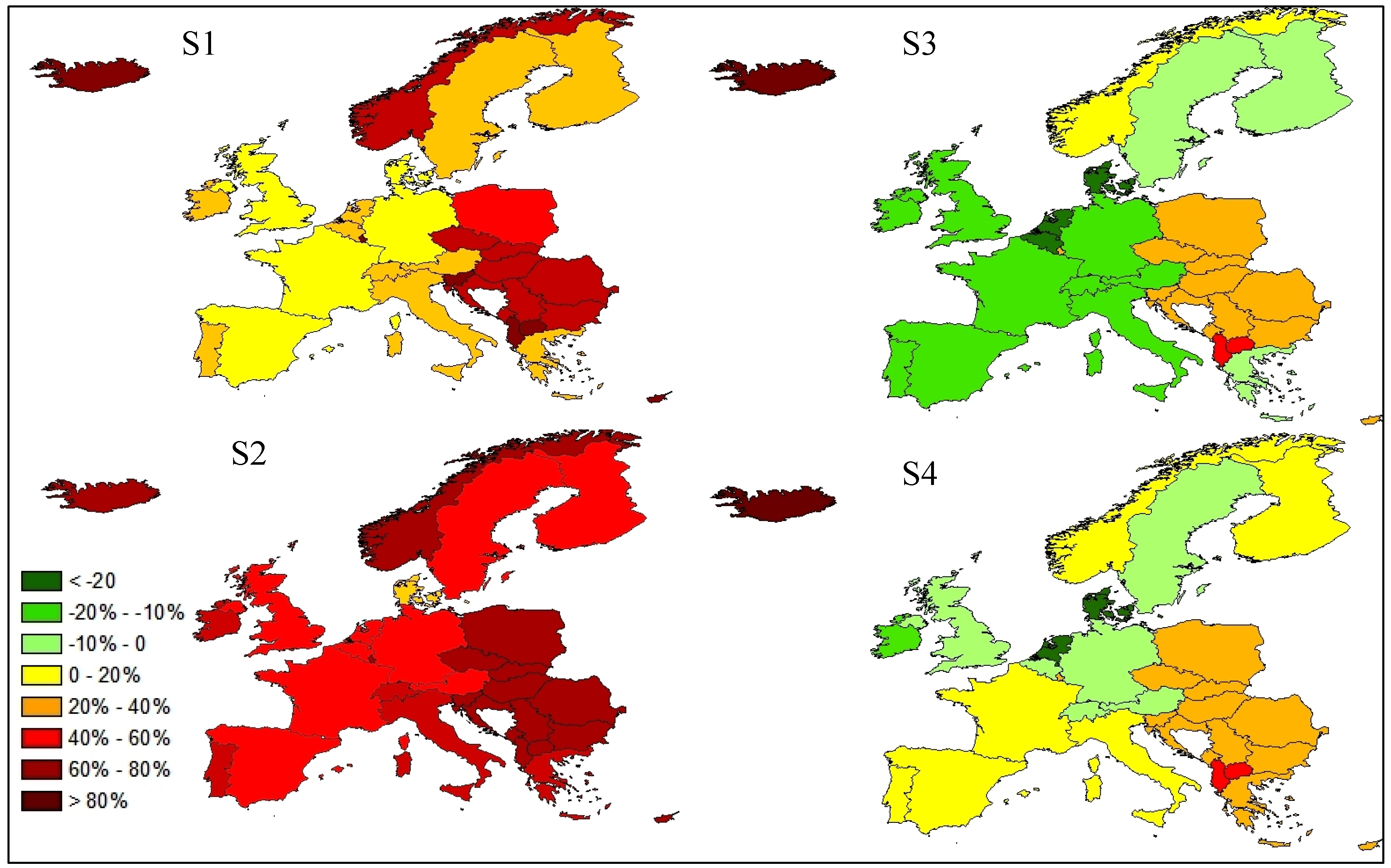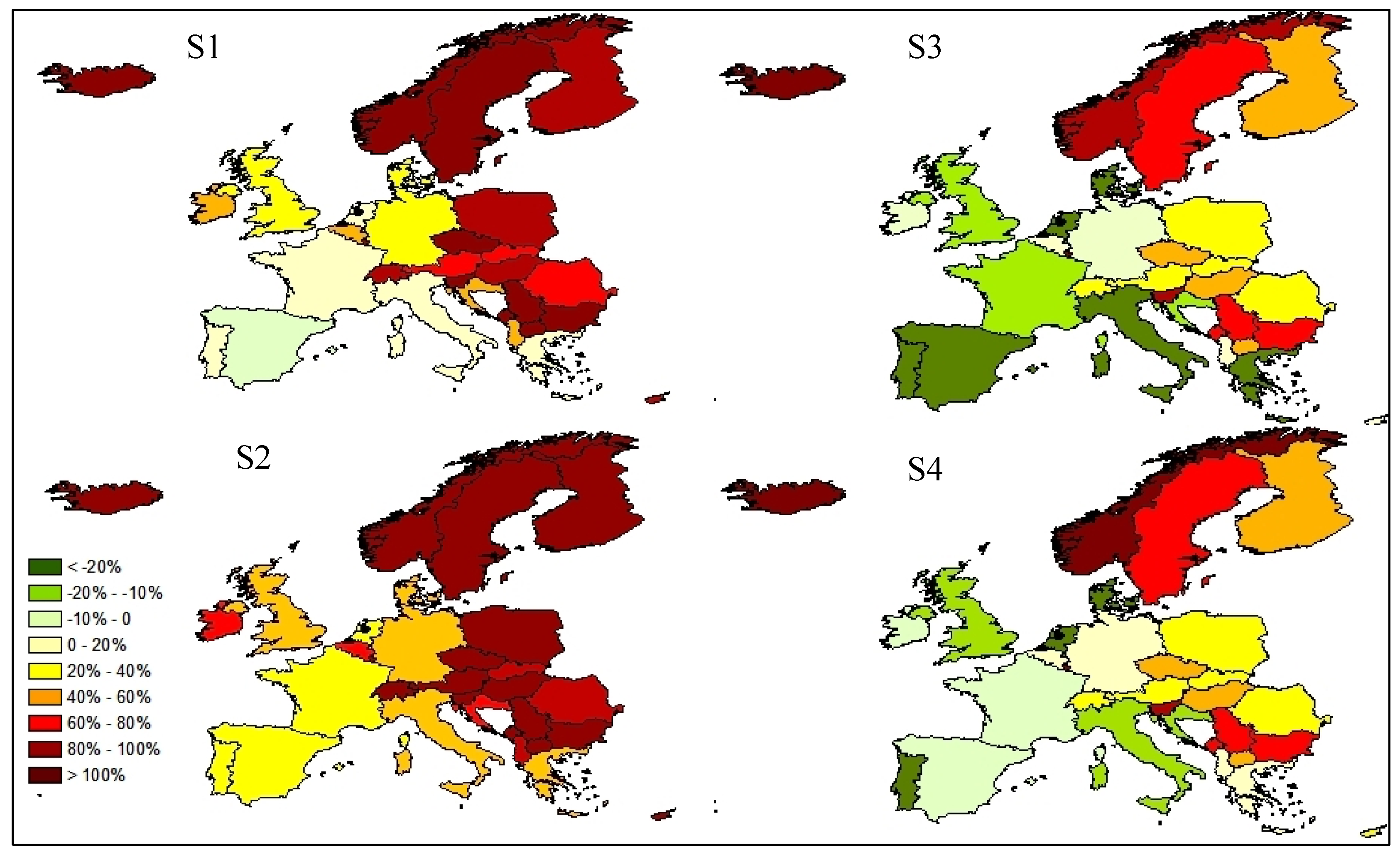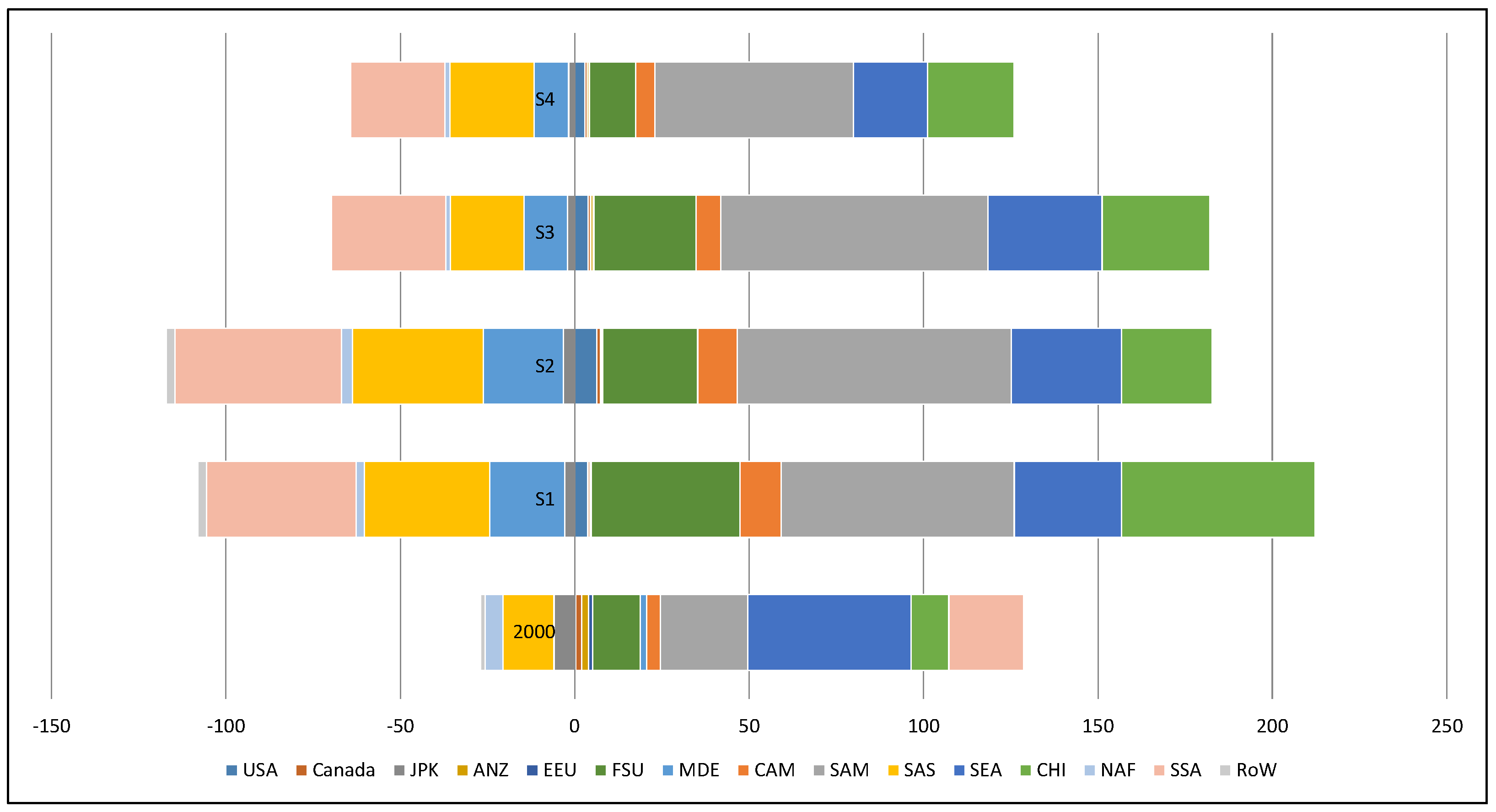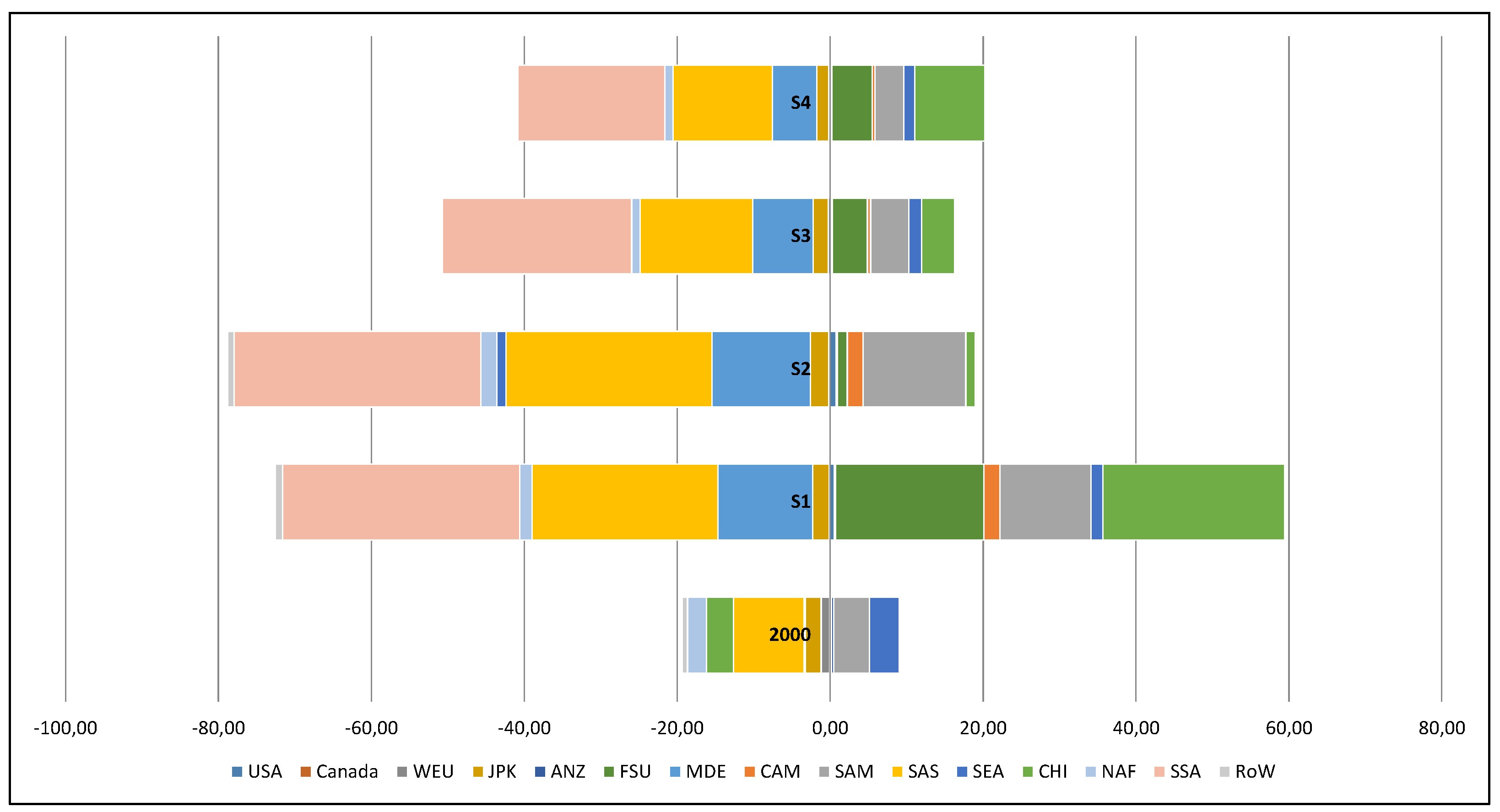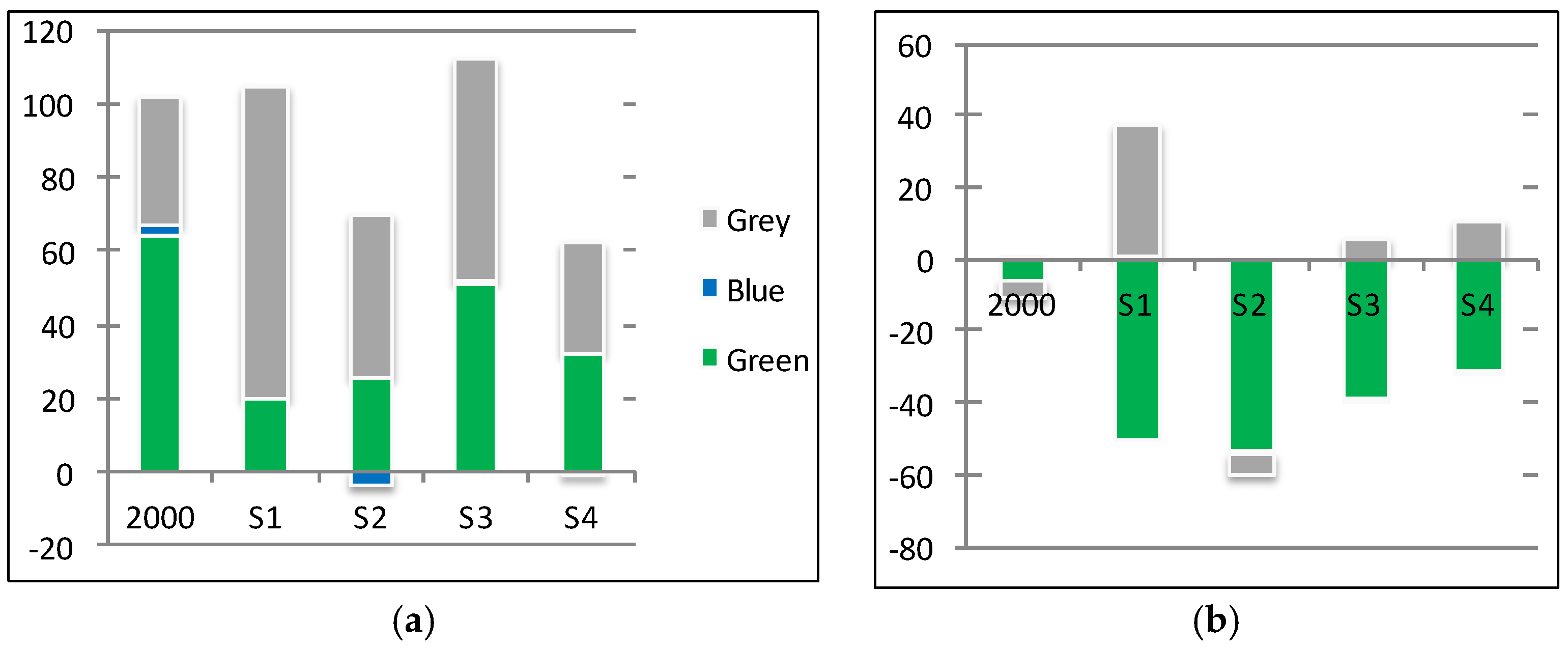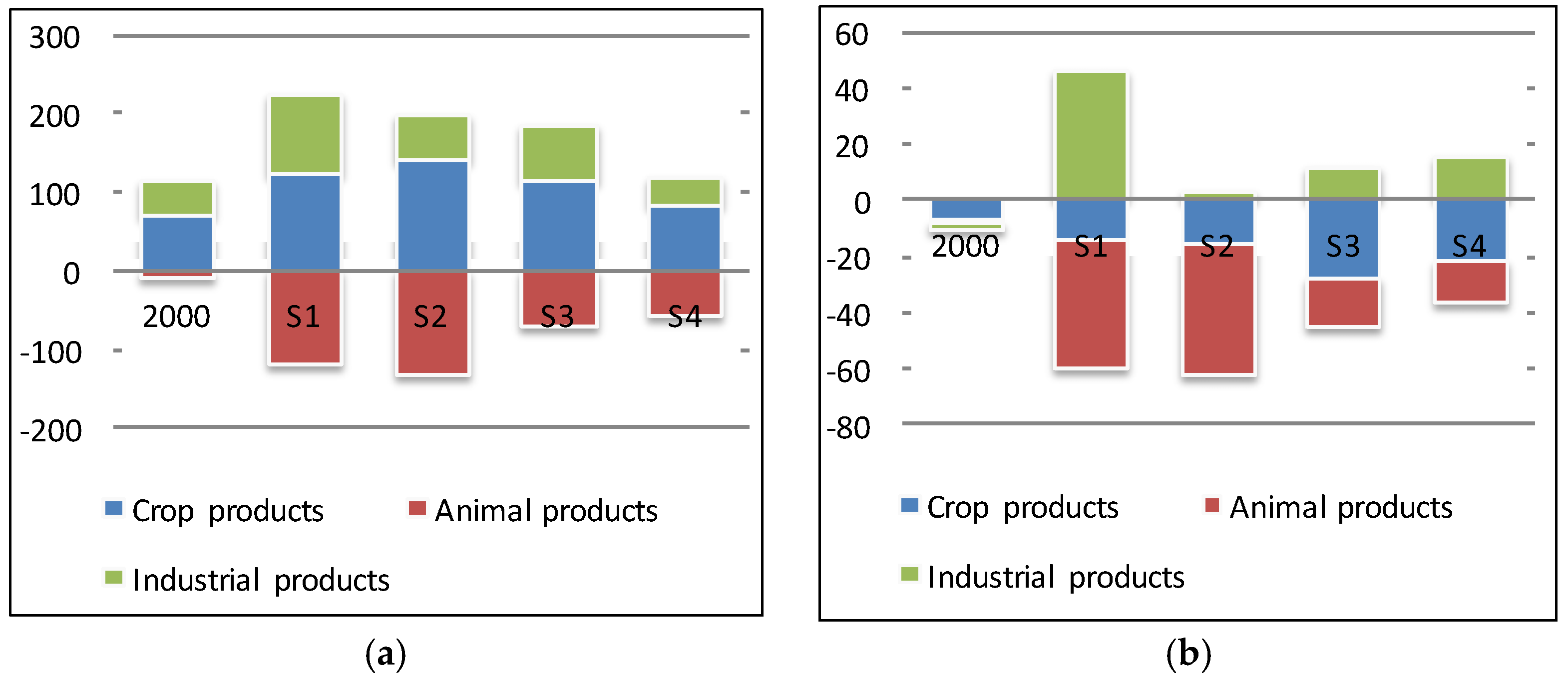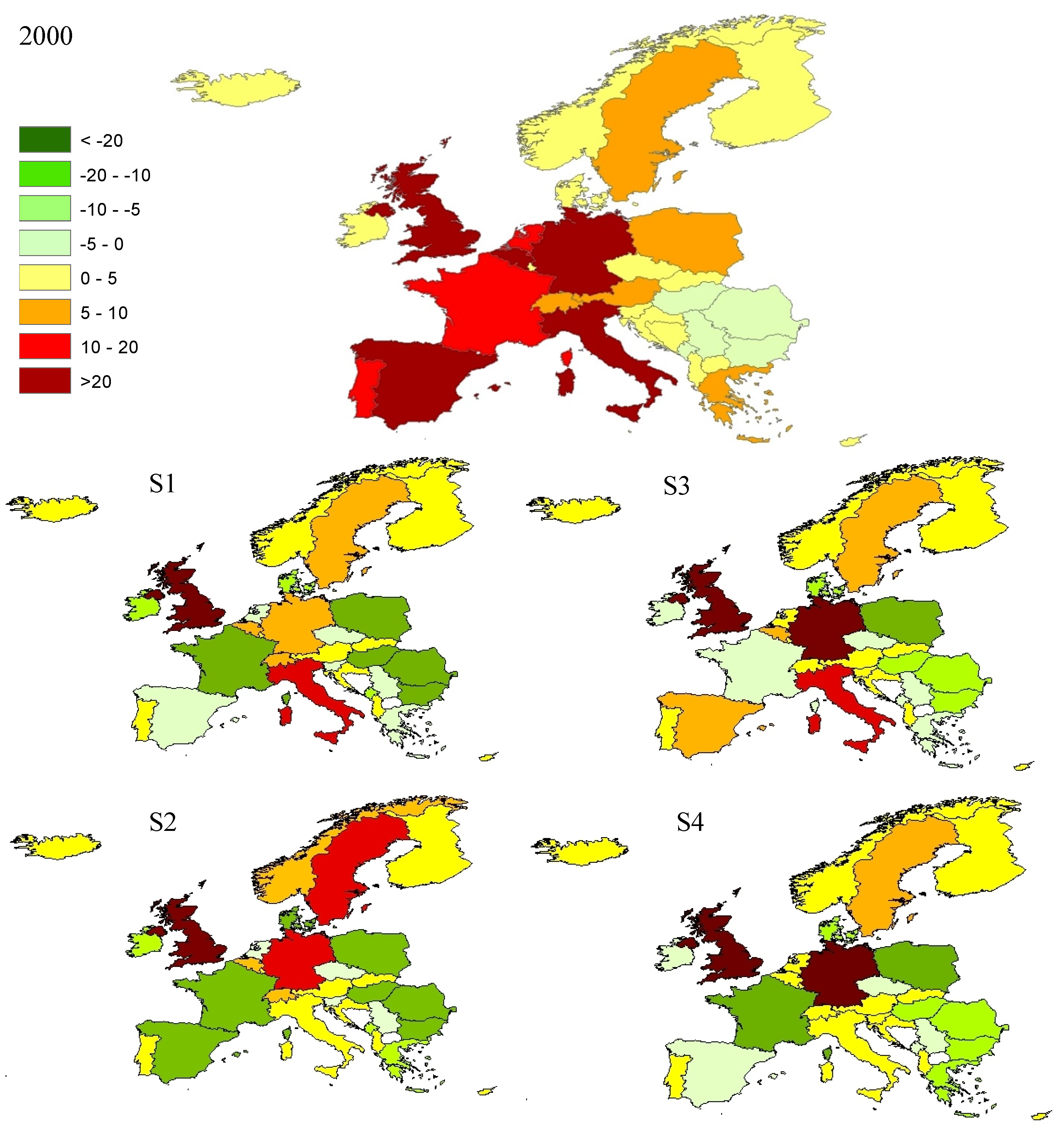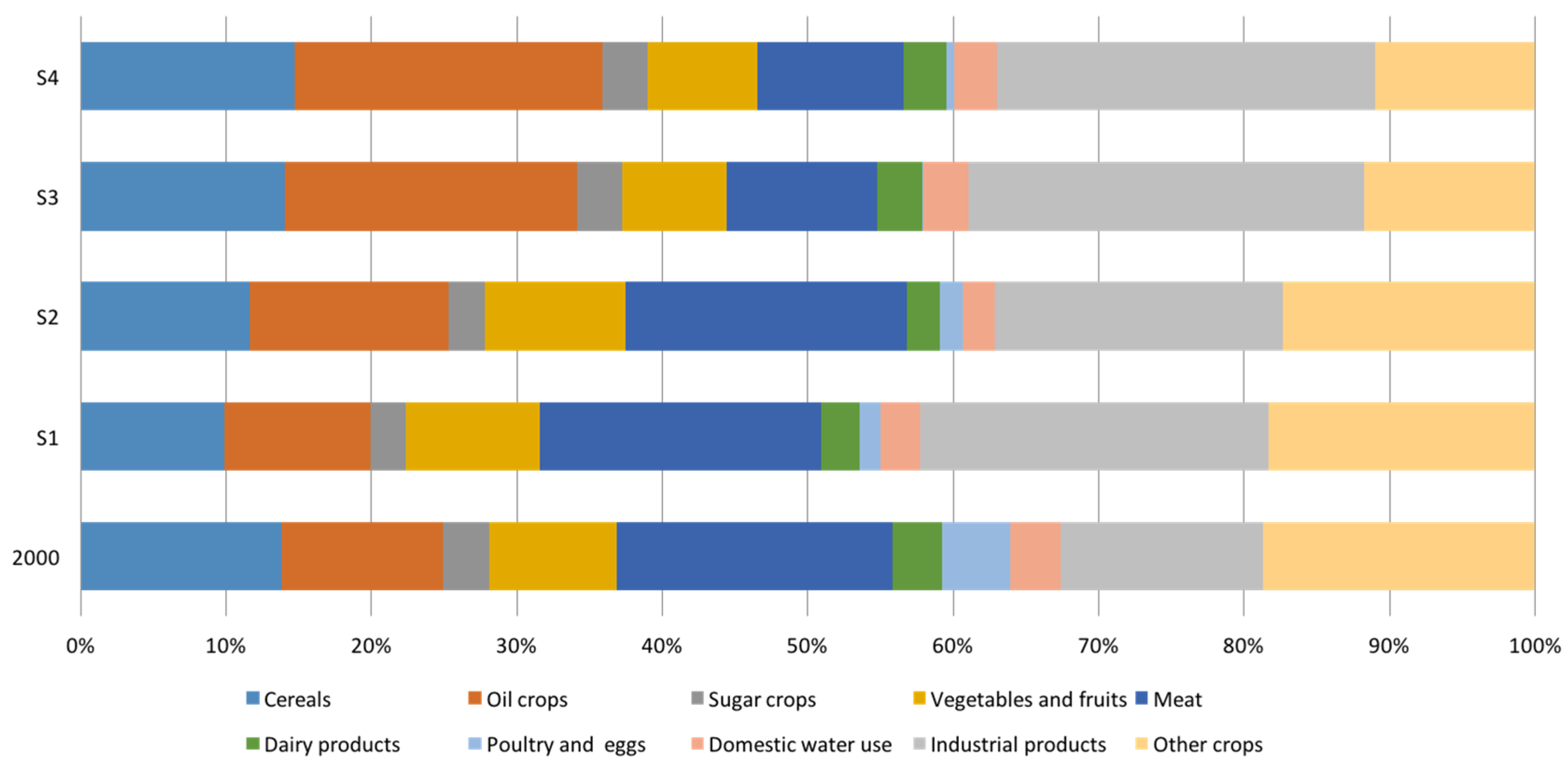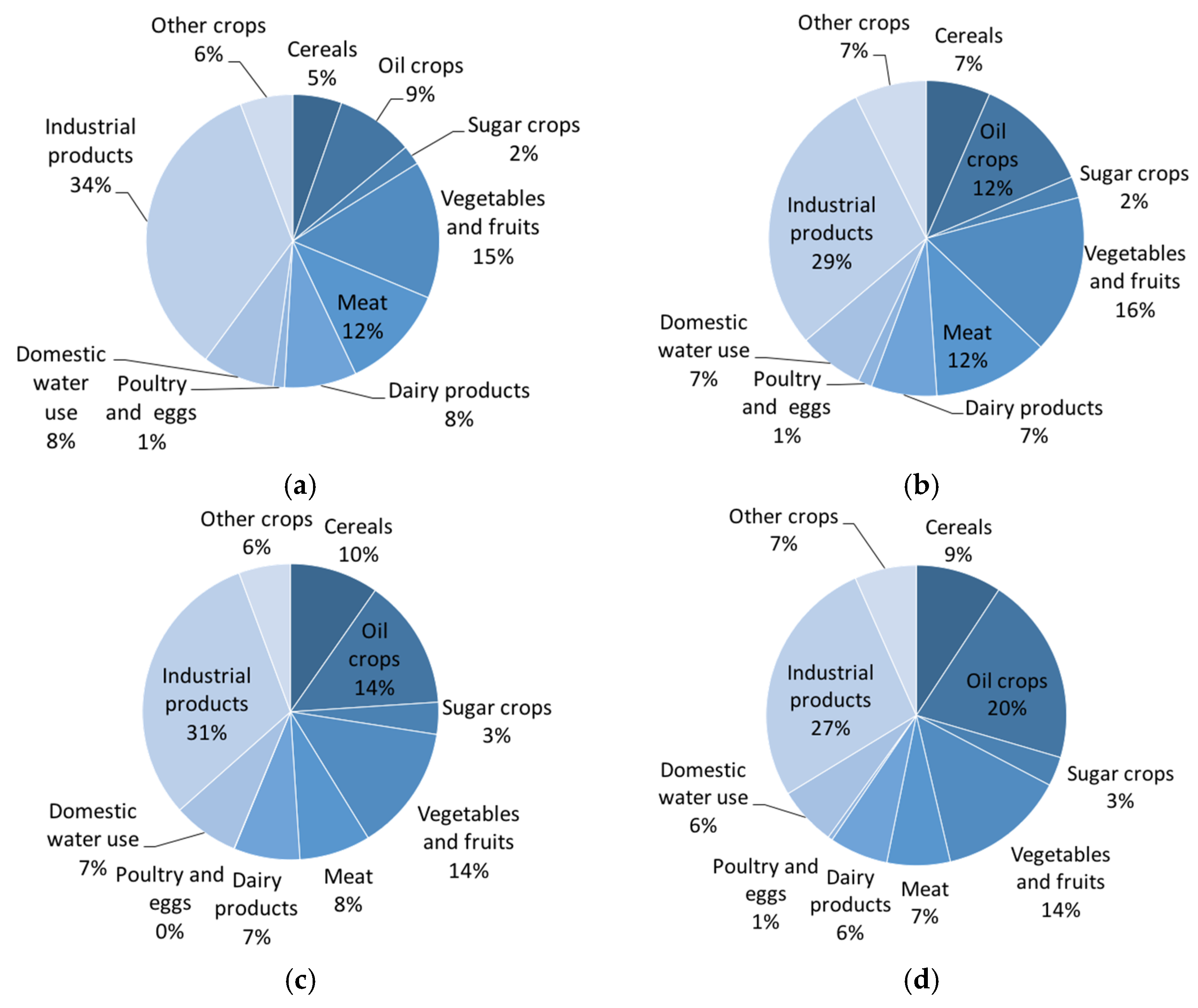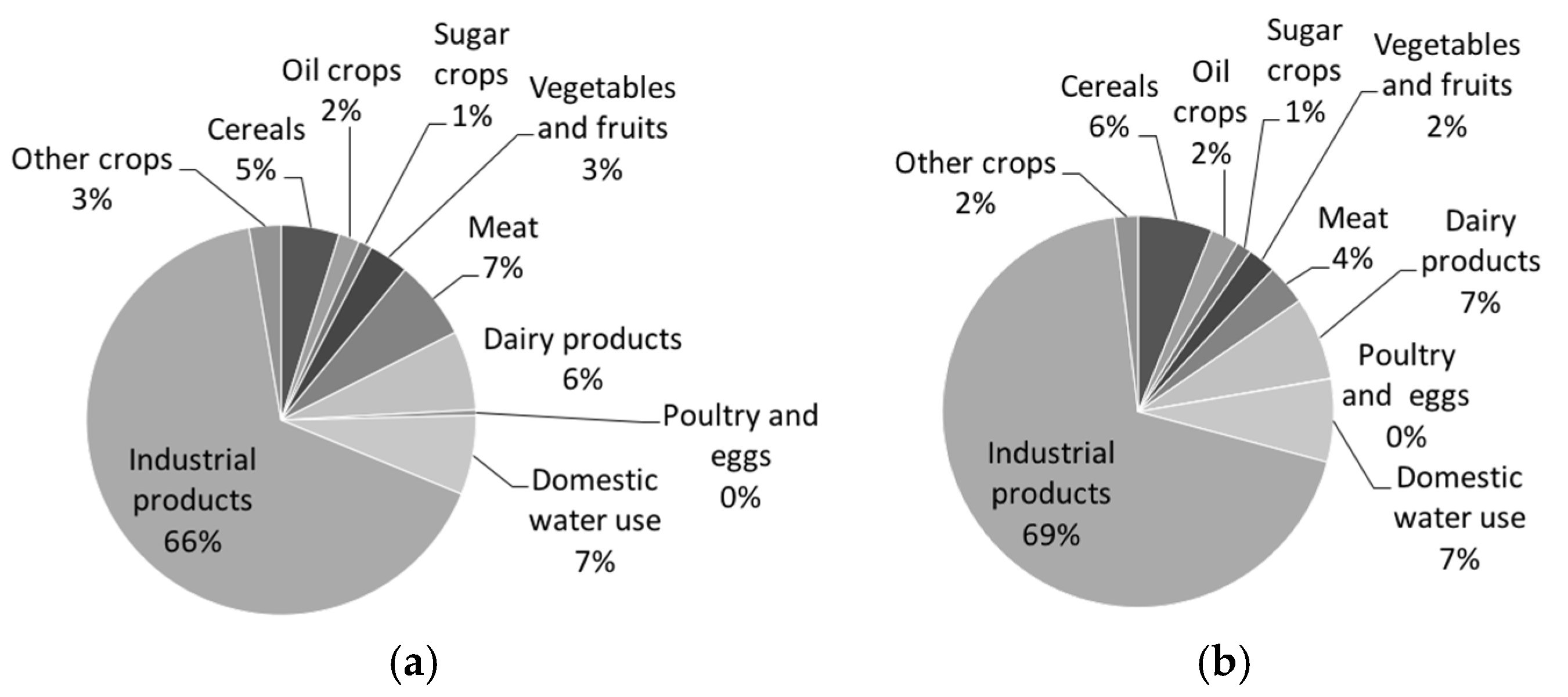3.1. Water Footprint of Production
The total WF of production in Western Europe (WEU) increases by +12% in S1 and +42% in S2 relative to 2000 values. It decreases 36% in S3 and 29% in S4. The green WF of production becomes 17% and 48% larger in S1 and S2 and 38% and 32% smaller in S3 and S4 compared to 2000. The blue component changes in a similar way: increases by 9 and 35% in S1 and S2 and decreases by 11% in S3 and 1% in S4 (
Figure 1). The grey component decreases in S1, S3 and S4 by 6, 40, 30% respectively, and increases by 22% in S2.
The WF of agricultural production in WEU increases by 19% in S1 and 51% in S2 and falls by 34% and 28% in S3 and S4 compared to 2000. The industrial WF of production in WEU decreases under all scenarios. The WF of domestic water supply reduces in S1, S3 and S4 but increases in S2 compared to 2000.
Eastern Europe (EEU) increases its WF of total production by +150% and +107% in S1 and S2, respectively, compared to 2000. The increase is lower in S3 and S4 than under the other scenarios, but volumes are 36% and 31% higher, respectively, than in 2000. The grey WF of production in EEU shows the greatest growth: 448% in S1, 174% in S2, 197% in S3 and 179% in S4. The blue WF of production increases significantly as well: 231% in S1, 94% in S2, 93% in S3 and 81% in S4. Increases can also be seen in the green WF of production, which is 51% and 86% larger than 2000 in S1 and S2, respectively. In S3 and S4, the green WF of production decreases (18%–19% lower than 2000).
The WF of industrial production in EEU in S1 becomes 8 times higher than in 2000. The less drastic but still large increase is also detected in the other scenarios. The WF related to agricultural production becomes larger in S1 and S2, by 50% and 85%, respectively. It stays below the 2000 volumes in S3 and S4. The WF of domestic water supply remains at the value of 2000 in S2 and decreases by around 24%–39% for S1, S3 and S4.
Among the agricultural products, the WF related to meat production has the largest share (28%) in the total for S1 and S2 in WEU. The share of meat production decreases to 19%–22% in S3 and S4. Oil crops and cereals increase their share in the total WF of production in S3 and S4 partly due to the high demand for biofuel by WEU. The WF of meat production shows the greatest increase in S1 and S2 but it decreases 20% in S3 and S4 compared to 2000. The WF of vegetable and fruit production increases largely in S1 and S2 and decreases by 20%and 30% in S3 and S4 compared to 2000. For most of product groups, the WF of production increases in S1/S2 and decreases in S3/S4. The total WF of oil crop and sugar crop production increases in S2 and S4 and decreases in S1 and S3, compared to 2000.
The WF of agricultural production increases notably in EEU in S1 and S2 for all product groups. The WFs related to the production of meat, dairy products, vegetables and fruits multiply by more than two times in S1 and S2. However, the total WF of production for these product groups reduces by 30% in S3 and S4. The total WF of sugar crop and oil crop production increases in S1, S2 and S4 compared to 2000. The increase in the overall WF of agricultural production is the highest in S2 because of the large population size and high meat content diet in this scenario.
On a national level, Eastern European countries like Poland, Hungary, Bulgaria and Romania become important producers and significantly increase their WF of consumption in S1 and S2 compared to 2000 (
Figure 2). The countries with the largest WF of production in 2000, like France and Spain, continue to have the largest WF of production in 2050. A shift from Southern Europe to Northern Europe is observed in the WF of cereal production. Norway, Luxembourg, Iceland, Cyprus and Malta have the highest increase in the WF of production in S1 and S2 compared to 2000.
All Eastern European countries have a larger WF of production in S3 and S4 relative to 2000, although the increase (around 30%) is smaller than the increases in the WF of production observed in S1 and S2. All of the WEU countries decrease their WF of production in S3 compared to 2000, except Cyprus, Malta, Iceland and Norway. A reduction in the WF of production is seen in the Netherlands, Belgium, Sweden, Germany, the UK, Ireland, Austria, Switzerland and Denmark in S4 compared to 2000. Spain and Italy, two counties with a large WF of production in 2000 in Europe, decrease their WF of production relative to 2000 only in S3 among all scenarios. Low-meat content diets and a shift of production to Central and Eastern Europe are the main reasons for this. Among the WEU countries, the Netherlands and Denmark have the highest reduction in the total WF of production compared to 2000, in S3 and S4. France reduces its WF of production in S3 but increases in S4 compared to 2000. Germany has a smaller WF of production in S3 and S4 compared to 2000.
With respect to the blue WF, the net abstraction from surface water and groundwater, many countries face an increase in all scenarios. This includes the four most northern countries (Norway, Sweden, Finland, Iceland) and most countries in Eastern Europe (
Figure 3). Most of the EEU countries double their blue WF of production in S1 and S2. They also have a larger blue WF of production in S3 and S4, except Croatia and Bosnia and Herzegovina. Serbia, the Czech Republic, Slovenia and Macedonia have the highest increase in blue WF of production in EEU. In most of Western Europe—except for the four most northern countries—we see an increase in the blue WF in scenarios S1 and S2, but a decrease in scenarios S3 and S4. In Austria, Switzerland, Belgium and Luxembourg, however, we find an increase in blue WF of production in all scenarios.
An increasing blue WF of production means increasing blue water scarcity. The severity of this water scarcity increase differs per country. Spain, Portugal, Cyprus, Malta, Italy, some parts of France (west and south east), the south-east part of the UK and Greece already experience significant to severe water scarcity at least one month a year under current conditions [
18]. The small island countries in Europe, Cyprus and Malta, increase their blue WF of production in S1 and S2 very significantly. These countries already experience high blue water scarcity, so scenarios S1 and S2 will be very problematic for these countries. The blue WF of production in Malta increases significantly in S3 and S4 as well. Scenario S2 shows an increase in blue water scarcity in all countries in Europe; the impacts will be largest in those regions that already experience recurrent or incidental severe water scarcity today, most in particular the countries in southern Europe. Under scenario S2, eastern European countries like Bulgaria and Romania will start facing severe water scarcity.
In a number of countries, water scarcity will decrease under some of the scenarios. Scenarios S3 and S4 show a reduction of blue WFs in the European countries that currently face highest water scarcity, which will reduce the pressure on their water resources and lessen the water scarcity. S3 yields the largest reduction of blue WF, especially for the countries experiencing the severest water scarcity: Spain, Italy and Greece. Pressures on the water resources in these countries will be reduced significantly under this scenario. Spain decreases its blue WF of production by 3% in S1, 27% in S3 and 5% in S4, but increases it by 32% in S2.
3.2. Virtual Water Flows
WEU is a net virtual water importer in 2000 (
Figure 4). It will remain a net virtual water importer; however, it decreases its net virtual water import in S2 and S4 compared to 2000. It increases its net virtual water import by +2% in S1 and +10% in S3. The reduction in net virtual water import by WEU is −35% in S2 and −40% in S4. Net virtual water imports to WEU were mainly from SEA, SAM, FSU, CHI and SSA in 2000. Virtual water import from SAM increases by around +200% in S1, S2 and S3 and +120% in S4, which makes SAM the biggest virtual water exporter to WEU in 2050. Although SEA has a large net virtual water export to WEU in 2050, its net virtual water export to WEU decreases by −35% for S1, S2 and S3 and −55% for S4. Net virtual water imports from Canada, EEU and ANZ decrease as well, more than −50% in all scenarios. Net virtual water import from the USA increases more than 10 times in 2050 for all scenarios but remains relatively small compared to the net virtual water exports from other regions. The virtual water import volume from FSU increases by 210% in S1, 100% in S2 and S3 but decreases by 4% in S4. WEU increases its net virtual water import from China by +410% in S1 and more than +100% in S2, S3 and S4. Being net virtual water exporters to WEU in 2000, SSA and MDE become net virtual water importers from WEU in 2050 for all scenarios. WEU is a net virtual water exporter to SAS, MDE, NAF, SSA and JPK in 2050. The largest net virtual water export is to SSA under all scenarios, followed by SAS and MDE. Net virtual water export by WEU to SSA increases significantly in 2050 due to increased trade in animal products.
Eastern Europe (EEU), a net virtual water exporter in 2000, remains so in 2050. It considerably increases its net virtual water export, by +100% S4 up to +500% in S2 compared to 2000 (
Figure 5). Its virtual water exports are higher than its imports from all the regions except the USA, Canada, CHI, SAM, FSU, CAM and ANZ in 2050. The largest net virtual water flow from EEU is to SSA, MDE and SAS in 2050. Being a net virtual water exporter to CHI and FSU in 2000, EEU becomes a net virtual water importer from these regions in 2050. Among the scenarios, net virtual water import by EEU is highest in S1 and lowest in S3.
Figure 6 shows the net virtual water flows from/to WEU and EEU by their green, blue and grey components. WEU is a net blue virtual water importer in 2000. In 2050, WEU becomes a net blue virtual water exporter in S2 and S4. By 2050, most of the net blue virtual water flows from WEU are to SSA, SAS and MDE and net blue virtual water imports to WEU are from SAM, the USA and ANZ. From the green water perspective, WEU is a net virtual water importer in all scenarios. As for the grey component, WEU continues to be a net importer in 2050 and increases its net virtual water import by +143% in S1, +29% in S2, +74% in S3. EEU is a net virtual water exporter in terms of green and blue components in 2050. It is a net grey virtual water importer in S1, S3 and S4 and exporter in S2. The green component has the biggest share in net virtual water exports from EEU.
The net virtual water import to WEU is mainly related to crop products and industrial products. The region is a net virtual water exporter considering animal products in 2050 (
Figure 7). The net virtual water export related to animal products increases very substantially in EEU as well. Although EEU is a net virtual water exporter in 2000 regarding all product groups, it becomes a net virtual water importer related to industrial products in 2050.
The virtual water export from EEU to WEU is larger than imports, therefore a net virtual water flow from EEU to WEU is observed in 2000. This continues towards 2050 but the net virtual water import by WEU from EEU is reduced largely in S1, by −90%.
Figure 8 shows net virtual water imports per nation in Europe for 2000 and four scenarios. All WEU countries are net virtual water importers in 2000. Countries like France, Spain, Ireland, Denmark, Greece and the Netherlands become net virtual water exporters in S1 and S2. In particular, the change in France is quite large. The UK, Italy, Portugal, Sweden, Norway, Finland, Germany, Austria, Belgium, Switzerland, Malta, Cyprus and Iceland remain net virtual water importers in S1 and S2. The net virtual water flow changes direction for some countries in S3. Spain and the Netherlands are net importers in S3. France, Denmark, Greece, and Ireland are net virtual water exporters in S3 and S4. Romania, Bulgaria, Serbia and Montenegro are net virtual water exporters in 2000 and stay so in 2050. Poland, the Czech Republic and Hungary are net virtual water importers in 2000 and become net virtual water exporters in 2050. Slovakia, Macedonia, Bosnia and Herzegovina, Croatia and Albania are net virtual water importers in 2000 and 2050. Slovenia is a net virtual water exporter in S1 and S2 and a net virtual water importer in S3 and S4.
3.3. Water Footprint of Consumption
The total WF of consumption in WEU increases by 28% and 52% in S1 and S2 compared to 2000. The WF of consumption in WEU decreases by −19% in S3 and −20% in S4. EEU increases its WF of consumption under all scenarios compared to 2000, by +143% in S1, +75% in S2, +17% in S3 and +20% in S4. The WF of consumption per capita in WEU increases by +30% in S1 and +22% in S2 and decreases by −18% in S3 and −28% in S4. EEU has a larger WF of consumption per capita in 2050 than in 2000, with an increase of 186% in S1, 57% in S2, 38% in S3 and 23% in S4. Approximately 70% of the total WF of consumption in WEU is green, in both 2000 and 2050. It is followed by the grey and blue components with shares of 20% and 10%, respectively. The share of green WF of consumption in the total in EEU decreases from 73% in 2000 to 34% in S1, S3 and S4. The share of grey WF of consumption in EEU increases from 23% in 2000 to 60% in S1, S3 and S4. The shares of the green, blue and grey components in the total WF of consumption in EEU in S2 are the same as the shares in 2000.
The WF of consumption per commodity group in Europe is given in
Figure 9. Meat (from cows, pigs, sheep and goats) and cereals are the product groups with the largest share in the WF of consumption in 2000. The share of meat consumption decreases in S1 and S2. It decreases considerably under the S3 and S4 scenarios. The WF related to the consumption of industrial products doubles its share in 2050 compared to 2000. Other commodities with a large share in the total WF of consumption in 2050 are cereals and oil crops. In particular, the share of oil crops significantly increases in S3 and S4, due to drastic biofuel expansion.
The blue WF of consumption in Europe is mainly due to industrial products in 2050 (
Figure 10). Vegetables and fruits are the second biggest contributor to the total blue WF of consumption in 2050 (14%–16%). The share of oil crops in total blue WF of consumption increases with 9% in S1, 12% in S2, 14% in S3 and 20% S4. The share of the blue WF of meat consumption in the total blue WF of consumption is 12% in S1 and S2, 8% in S3 and 7% in S4. Other product groups with a large share in the total blue WF of consumption are dairy products, domestic water supply and cereals, under all scenarios.
The grey WF of consumption is mainly from industrial products, with a share of 66% in S1 and S2 and 69% in S3 and S4. Domestic water supply is another large contributor to the total grey WF of consumption,
i.e., 7% of the total grey WF of consumption under all scenarios. Other product groups with a large share in the total grey WF of consumption are dairy products (6%–7%), cereals (5%–6%), meat (4%–7%) and vegetables and fruits (2%–3%). The composition of the grey WF of consumption does not differ much from scenario to scenario (
Figure 11).
The change in WF of consumption per capita relative to 2000 for the nations of Europe is shown in
Figure 12. All WEU countries have a larger WF of consumption per capita in S1 and S2 than 2000, except Denmark, Ireland, Luxembourg and the Netherlands. Belgium, Sweden, Cyprus, Iceland and Malta have a larger WF of consumption per capita in 2050 than in 2000. Austria, France, Greece, Italy, Norway, Portugal, Spain, Switzerland and the UK decrease their WF of consumption in S3 and S4 compared to 2000. Italy, the Netherlands, Spain, Switzerland, Luxembourg and the UK reduce their WF of consumption per capita values by more than −20% in S4. Within WEU, Cyprus, Malta and Iceland significantly increase their WF of consumption per capita in S1 and S2. Spain has the largest WF of consumption per capita in 2000. In 2050, Malta has the largest WF of consumption per capita.
In 2050, EEU countries have a larger WF of consumption per capita than in 2000. Bulgaria, Hungary, Croatia, Macedonia and Bosnia and Herzegovina increase their WF of consumption per capita by more than +100% in S1 and S2. Montenegro is the only country in EEU with a reduction in the WF of consumption per capita in S2.
The share of the external WF of consumption in the total WF of consumption increases in WEU in 2050. However, the countries with a relatively large external WF in 2000, like the Netherlands (94% of the total WF), Malta (90%) and Belgium (90%), significantly reduce this ratio, to below 50% under all scenarios. The UK, Switzerland and Luxembourg have an external WF of more than 60% of the total WF of consumption in all scenarios. Spain significantly reduces its share of external WF of consumption in 2050. All of the EEU counties reduce the share of external WF of consumption in S2, S3 and S4.

